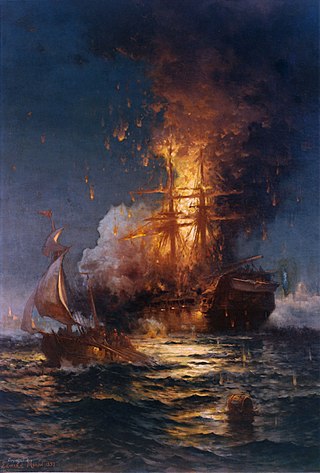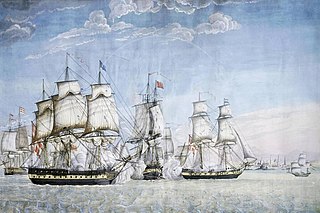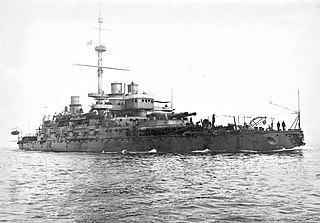
The First Barbary War (1801–1805), also known as the Tripolitan War and the Barbary Coast War, was a conflict during the Barbary Wars, in which the United States and Sweden fought against Tripolitania. Tripolitania had declared war against Sweden and the United States over disputes regarding tributary payments made by both states in exchange for a cessation of Tripolitanian commerce raiding at sea. United States President Thomas Jefferson refused to pay this tribute. Sweden had been at war with the Tripolitans since 1800. The First Barbary War was the first major American war fought outside the New World, and in the Arab world.

The Barbary Wars were a series of two wars fought by the United States, Sweden, and the Kingdom of Sicily against the Barbary states and Morocco of North Africa in the early 19th century. Sweden had been at war with the Tripolitans since 1800 and was joined by the newly independent US. The First Barbary War extended from 10 May 1801 to 10 June 1805, with the Second Barbary War lasting only three days, ending on 19 June 1815. The Barbary Wars were the first major American war fought entirely outside the New World, and in the Arab World.

The Bombardment of Kagoshima, also known as the Anglo-Satsuma War, was a military engagement fought between Britain and the Satsuma Domain in Kagoshima from 15 to 17 August 1863. The British were attempting to extract compensation and legal justice from daimyo Shimazu Tadayoshi for the 1862 Namamugi Incident, when a Royal Navy fleet commanded by Sir Augustus Leopold Kuper was fired on from Satsuma coastal batteries near Kagoshima. The British responded by bombarding the city in retaliation, but were unable to gain a conclusive victory and retreated two days later. The Satsuma declared victory and after negotiations fulfilled some British demands for the Namamugi Incident.

The Action of 16 May 1797 was a naval battle that took place near Tripoli in Ottoman Tripolitania. The Danish squadron was attacked by a Tripolitan squadron that outnumbered them in number of vessels. The result was a strategic victory for Tripoli.

The Ottoman–Egyptian invasion of Mani was a campaign during the Greek War of Independence that consisted of three battles. The Maniots fought against a combined Egyptian and Ottoman army under the command of Ibrahim Pasha of Egypt.
Yusuf Karamanli, Caramanli or Qaramanli or al-Qaramanli, (1766–1838) was the longest-reigning Pasha of the Karamanli dynasty of Tripolitania. He is noted for his role in the Barbary Wars against the United States.

The First Battle of Tripoli Harbor was a naval battle fought on May 16, 1802, in Tripoli Harbor between a combined force consisting of the American frigate USS Boston and two Swedish Navy frigates against several Tripolitan Barbary corsairs. The Swedish-American force was enforcing the blockade when an engagement broke out between it and Tripolitan forces. The Allied fleet damaged the Tripolitan squadron as well as the harbor fortifications before withdrawing and resuming the blockade.

The siege of Tripoli occurred in 1551 when the Ottoman Turks and Barbary pirates besieged and vanquished the Knights of Malta in the Red Castle of Tripoli, modern Libya. The Spanish had established an outpost in Tripoli in 1510, and Charles V remitted it to the Knights in 1530. The siege culminated in a six-day bombardment and the surrender of the city on 15 August.

The siege of Malta, also known as the siege of Valletta or the French blockade, was a two-year siege and blockade of the French garrison in Valletta and the Three Cities, the largest settlements and main port on the Mediterranean island of Malta, between 1798 and 1800. Malta had been captured by a French expeditionary force during the Mediterranean campaign of 1798, and garrisoned with 3,000 soldiers under the command of Claude-Henri Belgrand de Vaubois. After the British Royal Navy destroyed the French Mediterranean Fleet at the Battle of the Nile on 1 August 1798, the British were able to initiate a blockade of Malta, assisted by an uprising among the native Maltese population against French rule. After its retreat to Valletta, the French garrison faced severe food shortages, exacerbated by the effectiveness of the British blockade. Although small quantities of supplies arrived in early 1799, there was no further traffic until early 1800, by which time starvation and disease were having a disastrous effect on the health, morale, and combat capability of the French troops.

The action of 1 August 1801 was a single-ship action of the First Barbary War fought between the American schooner USS Enterprise and the Tripolitan polacca Tripoli off the coast of modern-day Libya.

Sicilia was the second of three Re Umberto-class ironclad battleships built for the Italian Regia Marina. The ship, named for the island of Sicily, was laid down in Venice in November 1884, launched in July 1891, and completed in May 1895. She was armed with a main battery of four 343 mm (13.5 in) guns and had a top speed of 20.3 knots, though this high speed came at the cost of armor protection.
The action of 22 June 1803 was a naval battle between the United States Navy and the Tripolitan Navy during the First Barbary War. Two ships from the American squadron blockading Tripoli, USS John Adams and USS Enterprise, met and engaged a Tripolitan polacre along with nine gunboats. After fighting a sharp action for forty five minutes the gunboats veered off and the polacre was abandoned. The Tripolitians later retook the polacre and were reengaged by the Americans before the vessel was destroyed in a large explosion.

The siege of Porto Ferrajo was a French attempt to force the surrender of the Tuscan fortress town of Porto Ferrajo on the island of Elba following the French occupation of mainland Tuscany in 1801 during the French Revolutionary Wars. The Tuscan garrison was heavily outnumbered, but received significant support from British Royal Navy forces who controlled the Mediterranean Sea and ensured that supplies reached the garrison and that French supply convoys were intercepted. The French began the siege with 1,500 men in May 1801, later reinforced to more than 5,000, but could not make an impression on the fortress's defences, instead seeking to starve the defenders into submission with the support of a squadron of French Navy frigates operating off the coast.

Dragut was an Ottoman corsair, naval commander, governor, and noble. Under his command, the Ottoman Empire's maritime power was extended across North Africa. Recognized for his military genius, and as being among "the most dangerous" of corsairs, Dragut has been referred to as "the greatest pirate warrior of all time", "undoubtedly the most able of all the Turkish leaders", and "the uncrowned king of the Mediterranean". He was nicknamed "the Drawn Sword of Islam". He was described by a French admiral as "a living chart of the Mediterranean, skillful enough on land to be compared to the finest generals of the time" and that "no one was more worthy than he to bear the name of king". Hayreddin Barbarossa, who was his mentor, stated that Dragut was ahead of him "both in fishing and bravery".
The Fashloom district is a suburb of Tripoli, Libya. It lies inland to the south of the suburb of Zawiyat al-Dahmani, and southeast of the Martyrs' Square. It is one of the more impoverished districts of the city.

The Battle of Tripoli took place between the navies of the Kingdom of Sardinia and Vilayet of Tripoli on 26 September 1825 during the Sardinian-Tripolitanian war of the same year. In order to resist Tripolitanian demands for increased tribute, the Sardinian king sent a squadron to force Tripoli to a favorable peace treaty. The Tripolitanians refused to change their demands and as a result the Sardinian squadron assaulted the city of Tripoli, sinking several vessels and landing a force to attack the city. Suffering heavy naval losses the Tripolitanian government quickly agreed to a favorable peace treaty with Sardinia, thus ending the war on favorable terms for the Sardinians.
Maktab al-Nasser prison is a prison in the Abu Salim district of Tripoli, Libya. Prior to the fall of Muammar Gaddafi's government in the 2011 Libyan civil war, it served as a prison and office of the internal security agency. Many of the prisoners held there would often be later transferred to Abu Salim prison.

The Royal Sardinian Navy was the naval force of the Kingdom of Sardinia. The fleet was created in 1720 when the Duke of Savoy, Victor Amadeus II, became the King of Sardinia. Victor Amadeus had acquired the vessels be used to establish the fleet while he was still the King of Sicily in 1713. The Sardinian Navy saw action in a number of conflicts, including the French Revolutionary Wars and the Napoleonic Wars from the 1790s to 1810s, limited actions against the Barbary Coast such as the Battle of Tripoli in 1825, and the Second Italian War of Independence in 1859. The last war was a major step toward Italian unification, which led to the creation of a united Italian state in 1861. During the fighting in 1860, the Royal Navy of the Two Sicilies either defected or surrender and was merged into the Sardinian Navy, resulting in the creation of the Regia Marina, which itself became the Marina Militare, the modern Italian navy, in 1946.

Until 1815 the Beylik of Tunis maintained a corsair navy to attack European shipping, raid coastal towns on the northern shores of the Mediterranean and defend against incursions from Algiers or Tripoli. After 1815 Tunis tried, with limited success, to create a modern navy, which fought in the Greek War of Independence and the Crimean War.

The Bombardment of Tripoli is a military operation of the Kingdom of France which took place between July 20 and July 27, 1728 against the current city of Tripoli, in Libya.














